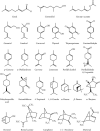A Narrative Review of the Antitumor Activity of Monoterpenes from Essential Oils: An Update
- PMID: 35655488
- PMCID: PMC9155973
- DOI: 10.1155/2022/6317201
A Narrative Review of the Antitumor Activity of Monoterpenes from Essential Oils: An Update
Abstract
Monoterpenes are a group of natural products that have been widely studied due to their therapeutic potential against various pathologies. These compounds are abundant in the chemical composition of essential oils. Cancer is a term that covers more than 100 different types of malignant diseases and is among the leading causes of death in the world. Therefore, the search for new pharmacotherapeutic options applicable to cancer is urgent. In this review, studies on the antitumor activity of monoterpenes found in essential oils were selected, and botanical, chemical, and pharmacological aspects were discussed. The most investigated monoterpenes were carvacrol and linalool with highly significant in vitro and in vivo tumor inhibition in several types of cancers. The action mechanisms of these natural products are also presented and are wildly varied being apoptosis the most prevalent followed by cell cycle impairment, ROS production, autophagy, necroptosis, and others. The studies reported here confirm the antitumor properties of monoterpenes and their anticancer potential against various types of tumors, as demonstrated in in vitro and in vivo studies using various types of cancer cells and tumors in animal models. The data described serve as a reference for the advancement in the mechanistic studies of these compounds and in the preparation of synthetic derivatives or analogues with a better antitumor profile.
Copyright © 2022 Thaíssa Q. Machado et al.
Conflict of interest statement
The authors declare that there is no conflict of interests regarding the publication of this paper.
Figures
Similar articles
-
Selected Monocyclic Monoterpenes and Their Derivatives as Effective Anticancer Therapeutic Agents.Int J Mol Sci. 2021 Apr 30;22(9):4763. doi: 10.3390/ijms22094763. Int J Mol Sci. 2021. PMID: 33946245 Free PMC article. Review.
-
Acaricidal efficacies of Lippia gracilis essential oil and its phytochemicals against organophosphate-resistant and susceptible strains of Rhipicephalus (Boophilus) microplus.Vet Parasitol. 2016 Sep 15;228:60-64. doi: 10.1016/j.vetpar.2016.05.028. Epub 2016 May 24. Vet Parasitol. 2016. PMID: 27692332
-
An overview of the pharmacological properties and potential applications of natural monoterpenes.Mini Rev Med Chem. 2014;14(14):1156-68. doi: 10.2174/1389557514666141127145820. Mini Rev Med Chem. 2014. PMID: 25429661 Review.
-
Analgesic Potential of Essential Oils.Molecules. 2015 Dec 23;21(1):E20. doi: 10.3390/molecules21010020. Molecules. 2015. PMID: 26703556 Free PMC article. Review.
-
Composition and cytotoxic activity of essential oils from Xylopia aethiopica (Dunal) A. Rich, Xylopia parviflora (A. Rich) Benth.) and Monodora myristica (Gaertn) growing in Chad and Cameroon.BMC Complement Altern Med. 2014 Apr 4;14:125. doi: 10.1186/1472-6882-14-125. BMC Complement Altern Med. 2014. PMID: 24708588 Free PMC article.
Cited by
-
Plant-Derived Terpenoids: A Plethora of Bioactive Compounds with Several Health Functions and Industrial Applications-A Comprehensive Overview.Molecules. 2024 Aug 15;29(16):3861. doi: 10.3390/molecules29163861. Molecules. 2024. PMID: 39202940 Free PMC article. Review.
-
Essential Oils: Chemistry and Pharmacological Activities.Biomolecules. 2023 Jul 18;13(7):1144. doi: 10.3390/biom13071144. Biomolecules. 2023. PMID: 37509180 Free PMC article. Review.
-
Therapeutic Effects of Essential Oils and Their Bioactive Compounds on Prostate Cancer Treatment.Pharmaceutics. 2024 Apr 24;16(5):583. doi: 10.3390/pharmaceutics16050583. Pharmaceutics. 2024. PMID: 38794244 Free PMC article. Review.
-
Lavender Essential Oil and Its Terpenic Components Negatively Affect Tumor Properties in a Cell Model of Glioblastoma.Molecules. 2024 Dec 22;29(24):6044. doi: 10.3390/molecules29246044. Molecules. 2024. PMID: 39770132 Free PMC article.
-
A Green Microwave-Assisted Extraction of Cannabis sativa L. Extract and Its Cytotoxic Activity Against Cancer Cells.Turk J Pharm Sci. 2025 Mar 7;22(1):64-70. doi: 10.4274/tjps.galenos.2025.33490. Turk J Pharm Sci. 2025. PMID: 40052396 Free PMC article.
References
Publication types
MeSH terms
Substances
LinkOut - more resources
Full Text Sources
Medical


